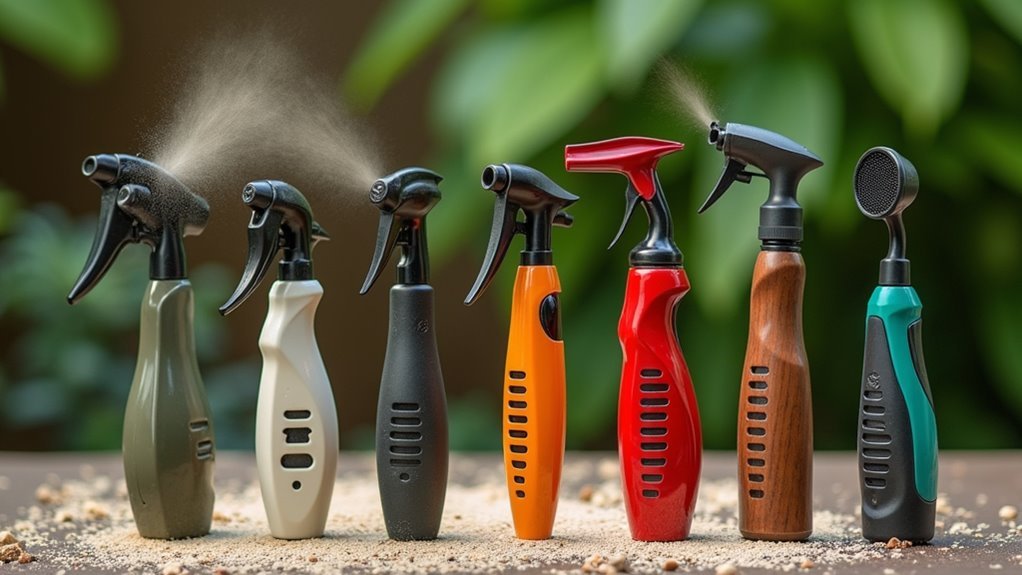You’ve likely noticed ticks becoming a growing concern in your yard, bringing with them the risk of Lyme disease and other infections. Traditional chemical treatments often fall short, leaving you and your pets vulnerable. Tick control tubes offer a targeted solution by disrupting the disease cycle at its source – not just killing adult ticks, but preventing new generations from becoming infected. The right tubes can protect your outdoor spaces without covering your entire property in pesticides. Let’s explore the most effective options.
Thermacell Tick Control Tubes for Yards
If you’re looking for an environmentally friendly way to combat deer ticks without harsh chemicals, Thermacell Tick Control Tubes offer an ideal solution. Developed at Harvard University, these tubes target the disease cycle by providing treated nesting material that mice collect, effectively killing ticks where they first encounter hosts.
Each pack contains 12 tubes that protect up to half an acre. For best results, place them near mouse habitats like rock walls, wood piles, and gardens twice yearly—spring and summer. Users consistently report significant reductions in tick populations, making these tubes especially valuable in Lyme-prevalent regions like New England and the Mid-Atlantic.
Best For: Homeowners in Lyme disease prevalent regions like New England and Mid-Atlantic who want an environmentally friendly alternative to chemical tick treatments for their yards.
Pros:
- Environmentally friendly solution that doesn’t use harsh chemicals, making it safe for families, pets, and wildlife
- Easy application process requires placing tubes only twice yearly (spring and summer) for continuous protection
- Developed at Harvard University with scientific backing and consistently positive customer reviews reporting significant tick reduction
Cons:
- Requires strategic placement near mouse habitats for maximum effectiveness, which may be challenging for some users to identify
- Protection limited to approximately half an acre per 12-tube package, requiring multiple packages for larger properties
- Works indirectly through the mouse-tick cycle, meaning results may not be as immediate as direct chemical treatments
Tick Tubes 20 Pack for Tick Control (Covers 1.5 Acres)
Homeowners with larger properties up to 1.5 acres will find exceptional value in the Tick Tubes 20 Pack, which delivers effective tick control at just $1 per tube—a fraction of competitors’ $3 price tag. These biodegradable tubes from Brooksie Naturals provide an eco-friendly solution that’s safe for families and pets.
You’ll need to purchase 0.5% Permethrin separately, but this one-time investment lasts considerably longer than pre-made alternatives that can cost $60+ annually. Simply fill tubes with treated cotton and place 10-12 per acre in mouse-frequented areas. The mice then distribute the material, tackling ticks at their source.
Best For: Environmentally-conscious homeowners with larger properties who want an affordable, pet-safe solution for long-term tick control without chemicals across their yard.
Pros:
- Significantly more affordable than competitors at $1 per tube versus $3, with potential annual savings of over $140
- Biodegradable materials make this an eco-friendly tick control method that breaks down naturally
- Safe for families and pets since the treatment targets mice habitats rather than requiring widespread yard application
Cons:
- Requires separate purchase of 0.5% Permethrin, creating an additional shopping step
- Some assembly required as users must fill tubes with treated cotton themselves
- Average customer rating of 3.0 stars suggests mixed results or satisfaction among users
Safe & Complete Tick Removal Tool Kit with Stainless Steel Tools
When dealing with the dangerous reality of tick bites, having the right tools can make all the difference in preventing disease transmission. This stainless steel kit includes everything you’ll need: a specialized remover tool, precision tweezers, protective case, and tick ID card.
You’ll appreciate the surgical-grade construction that’s dishwasher safe for proper sterilization. The compact case fits easily in pockets, purses, or vehicles—perfect for hiking or camping trips.
Effective on humans and animals alike, this kit helps minimize infection risk through complete tick removal. Plus, your purchase supports cancer research, as Aletka donates 100% of net profits to the Cancer Research Institute.
Best For: Outdoor enthusiasts, pet owners, and families who want a complete tick removal solution that’s easy to use while supporting cancer research.
Pros:
- Comprehensive kit includes all necessary tools for safe and complete tick removal
- Surgical-grade stainless steel construction is durable and dishwasher safe for proper sterilization
- 100% of net profits are donated to the Cancer Research Institute for cancer research
Cons:
- May require some practice to use effectively for first-time users
- Single-purpose tool that might not be needed frequently depending on your location
- Limited customer reviews (only 10 ratings) despite perfect 5-star rating
Factors to Consider When Choosing Tick Control Tubes That Interrupt the Disease Cycle
When selecting tick control tubes to break the disease transmission cycle, you’ll need to evaluate key factors that determine effectiveness for your property. Consider your yard’s size for proper coverage, how often you’ll need to reapply based on seasonal tick activity, and whether the product offers an environmentally responsible solution that won’t harm beneficial wildlife. You should also weigh the cost-efficiency of commercial options versus making your own tubes, as both approaches can effectively deploy permethrin-treated cotton that mice use for nesting material.
Coverage Area Assessment
Five critical coverage factors determine whether your tick control solution will effectively protect your property. First, evaluate how much area the tubes can protect—some products cover up to 1.5 acres while others only protect ½ acre per application. Second, follow recommended tube density guidelines; most effective solutions suggest 10-12 tubes per acre in mouse-frequented areas.
Third, timing matters—many products require biannual applications during spring and summer when tick populations surge. Fourth, consider proper spacing between tubes, typically 10 yards apart, to create an effective defense network across your property. Finally, assess the biodegradable properties of the tubes, which affect both their environmental impact and how long they’ll remain effective in your yard before needing replacement.
Application Frequency Needs
Consistently maintaining the right application schedule for tick control tubes is essential to effectively interrupt the disease cycle. You’ll need to apply these tubes twice yearly—once in spring and again in summer—to target peak tick activity periods and break their life cycle effectively.
Space your tubes no more than 10 yards apart to guarantee rodent hosts encounter and distribute the treated materials throughout your property. This strategic placement maximizes your protection against Lyme disease and other tick-borne illnesses.
Missing recommended application intervals can quickly lead to tick population rebounds, undermining your prevention efforts. By following the suggested twice-yearly schedule, you’ll create a consistent protective barrier during the warmer months when you and your family spend more time outdoors, considerably reducing your exposure risk.
Environmental Safety Profile
Because environmental impact matters as much as effectiveness, carefully examine the safety profile of tick control tubes before purchase. Look for biodegradable options that naturally decompose after use, preventing long-term ecological damage while still disrupting the tick life cycle.
Prioritize products that specifically target ticks without harming beneficial insects, birds, or other wildlife that help maintain ecosystem balance. Chemical-free alternatives provide effective control while creating safer outdoor spaces for your family and pets.
You’ll want to verify that your chosen tubes have undergone thorough safety testing, confirming they pose minimal risk to non-target species. The best tick control tubes work by interrupting the pest’s life cycle rather than broadly applying pesticides, making them a responsible choice for environmentally conscious homeowners seeking sustainable pest management solutions.
Cost Per Treatment
While environmental safety establishes a product’s ecological merit, your budget ultimately determines which tick control solution fits your household needs. When evaluating price points, you’ll find significant variations—from budget-friendly options at $1 per tube to premium products costing $3-$5 each.
Look beyond the sticker price to assess true value. Compare coverage area per package, as some tubes treat up to 1.5 acres while others only handle ½ acre. Don’t forget to factor in additional expenses like separately purchased permethrin, which can increase your total investment.
Consider the long-term financial perspective too. Biodegradable options might cost more upfront but align with eco-friendly goals. Most importantly, weigh these costs against potential savings from preventing tick-borne diseases, which can result in substantial medical expenses.
DIY Vs Premade
When making the choice between DIY and premade tick control tubes, you’re balancing cost against convenience. DIY options cost around $1 per tube compared to $3+ for premade versions, offering substantial savings for large properties requiring multiple treatments.
Premade tubes come ready to use with treated cotton, eliminating the need to purchase and handle Permethrin separately. While this saves time, DIY solutions give you control over materials and treatment strength.
Both options require proper placement—10-12 tubes per acre—to effectively reduce tick populations. Consider your environmental priorities too; some DIY tubes can be made with biodegradable materials, while commercial options vary in their ecological impact.
Your decision ultimately depends on whether you value the cost savings of DIY or the convenience of grab-and-go solutions.
Regional Effectiveness Variations
Tick control tubes deliver markedly different results across geographic regions, with northeastern states like Connecticut and Massachusetts seeing ideal effectiveness due to their high deer tick populations. If you’re in these Lyme-endemic areas, you’ll likely experience better outcomes than in regions with fewer deer ticks.
Consider your local mouse population too—these rodents are essential for distributing the permethrin-treated cotton to their nests. Areas with abundant mice tend to show superior results from tick tube deployment.
Timing your application to coincide with spring and early summer tick activity maximizes effectiveness. Be aware that your region’s specific humidity and temperature patterns affect both tick survival and control tube performance. For best results, choose products designed for the particular tick species in your area, as lifecycle differences impact control strategies.
Installation Location Planning
Strategic placement of tick control tubes dramatically increases their effectiveness in breaking the disease transmission cycle. You’ll want to target areas mice frequently visit—rock walls, wood piles, and brushy zones—since these rodents are essential for distributing the tick-controlling materials throughout your property.
Space tubes no more than 10 yards apart to guarantee thorough coverage. For best results, install them during early spring and late summer when they’ll have the greatest impact on the tick life cycle. If you’re in a region with high Lyme disease prevalence, prioritize these areas for installation.
Consider using a higher density of 10-12 tubes per acre to maximize effectiveness. This approach greatly enhances the chances of mice encountering the treated cotton and distributing it to their nesting areas.
Frequently Asked Questions
How Often Should Tick Control Tubes Be Replaced?
You’ll need to replace tick control tubes every 6-8 weeks during tick season (spring through fall). Don’t wait too long between replacements as the cotton nesting material becomes less effective over time.
Can Tick Tubes Harm Beneficial Insects or Wildlife?
Tick tubes primarily target mice, not beneficial insects. They contain permethrin that’s safely contained inside tubes where only mice collect nesting material. You won’t harm pollinators, birds, or other wildlife when used correctly.
Do Tick Tubes Work Against All Tick Species?
Tick tubes don’t work against all tick species. They’re primarily effective against blacklegged (deer) ticks. You’ll need different strategies for lone star, American dog, or other tick species carrying different diseases.
Are Tick Tubes Safe to Use Around Vegetable Gardens?
Yes, tick tubes are generally safe to use around vegetable gardens. They contain permethrin that primarily targets ticks on mice, not your plants. You’ll want to place them along garden edges, not directly in beds.
What Months Are Most Effective for Deploying Tick Tubes?
Deploy tick tubes in early spring (March-April) when nymphs emerge and again in late summer (August-September) when larvae are active. You’ll get the best results targeting these two key lifecycle periods.





Leave a Reply